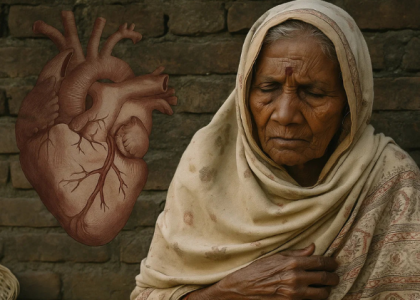A Message for All Sisters, Mothers, and Daughters
Many people think heart attacks only happen to men. You might picture an older man clutching his chest and falling to the ground. This is what we see in movies and TV shows.
But this is not the full truth. Women get heart attacks too. And South Asian women face special risks.
South Asian Women and Heart Disease: The Hidden Truth
If you are a woman from India, Pakistan, Bangladesh, Sri Lanka, Nepal, or Bhutan, you should know an important fact: South Asian women have a higher chance of getting heart disease compared to women from other backgrounds [1].
Even more concerning, heart disease can happen to South Asian women at younger ages – sometimes 10 years earlier than women from other groups [2].
You might be thinking, “But I feel fine! I take care of my family, I work hard, I have no pain.” It’s important to know that heart disease can build up silently for years before you feel any symptoms.
Women’s Heart Attack Symptoms Can Be Different
When men have heart attacks, they often feel strong chest pain. But for women, the signs can be different and less obvious.
Women having a heart attack might feel:
- Unusual tiredness that doesn’t go away with rest
- Nausea or vomiting that comes suddenly
- Pain in the jaw, neck, or back
- Pressure in the upper part of the stomach
- Shortness of breath when doing normal activities
- Dizziness or feeling lightheaded
Sunita, a 48-year-old mother from Mumbai now living in America, thought she had the flu. She felt very tired, had some nausea, and her back was aching. When she finally went to the doctor, they discovered she had a heart attack. “I never thought it could be my heart. I always thought heart attacks meant chest pain,” she said.
Why Are South Asian Women at Higher Risk?
There are several reasons:
Our bodies process fats differently. South Asians often have higher levels of certain blood fats, even when we’re not overweight [3].
Diabetes is more common. South Asian women get diabetes more often, and diabetes increases heart disease risk [4].
Our waistlines matter. A waist measurement over 32 inches (80 cm) for South Asian women is considered a risk factor, while for other women the number is 35 inches (88 cm) [5].
Cultural factors play a role. Many South Asian women put their family’s health before their own. We may cook healthy food for our families but don’t make time to exercise or relax.
Breaking the Myth: “It’s Only a Man’s Disease”
For too long, heart disease has been seen as a man’s problem. This myth has put women’s lives at risk. When we don’t know we’re at risk, we might ignore warning signs.
Many women think cancer is their biggest health threat. But heart disease kills more women than all types of cancer combined.
What You Can Do to Protect Your Heart
The good news is that you can take steps to keep your heart healthy:
Know your numbers. Ask your doctor to check your:
- Blood pressure
- Cholesterol levels
- Blood sugar
- Waist measurement
Move more each day. Even 30 minutes of walking can help your heart.
Look at family meals. Try to:
- Use less oil and ghee in cooking
- Add more vegetables to each meal
- Choose brown rice instead of white rice sometimes
- Eat more dals and beans
Take stress seriously. Find time each day to relax, even if it’s just 10 minutes of quiet breathing.
Talk to your doctor. If you have family members who had heart problems, tell your doctor. Ask if you should have special tests like an ApoB or Lp(a) test.
Remember: Your Heart Matters Too
As women, especially South Asian women, we often put everyone else first. We care for our children, our parents, our husbands, and our communities.
But remember: your heart matters too. Taking care of your heart is not selfish – it’s necessary so you can continue to be there for those you love.
If you ever feel unusual symptoms like extreme tiredness, nausea, jaw pain, or shortness of breath that doesn’t seem normal, don’t wait. Call for emergency help. It’s better to be safe.
Your family needs you. Your community needs you. And you deserve to live a long, healthy life with a strong heart.
References
- American Heart Association. (2023). “South Asians’ high risk of cardiovascular disease has been hidden by a lack of data.” Link
- Stanford Health Care. (2022). “Heart Disease in South Asians.” Link
- American Heart Association. (2018). “Atherosclerotic Cardiovascular Disease in South Asians in the United States.” Link
- National Center for Biotechnology Information. (n.d.). “South Asians and coronary heart disease: always bad news?” Link
- Indian Heart Association. (2015). “South Asian Women & Heart Disease.” Link




